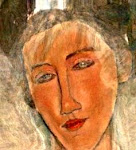I was born and raised in the city but converted to country life. The turning point came after experiences of living in numerous places – cities, small towns and countryside in Italy, England, France, Germany and Israel.
Although I
don’t feel any particular roots, I have happily settled down – for the time
being – in an idyllic place in the Italian country, trying to be an olive
farmer and quite enjoying it.
It’s a very
tranquil life that follows nature’s slow rhythms. No stress. Sometimes I feel I long for a
little stress, so I visit a city. This I do on the occasion of the birthdays of
my partner or mine, and this year was no exception: Venice was in the agenda.
However, we added two extra destinations, a smaller town (Cremona) and a tiny hamlet
in the Po valley (Roncole di Busseto). A theme links all three: classical
music. Cremona is
the cradle of violin making, Antonio Vivaldi was born in Venice and Busseto was
the birthplace of Giuseppe Verdi.
Verdi, the
“Swan of Busseto” was actually born in Roncole in a modest house, now a tourist
destination. The plaque commemorates the restoration of Verdi's birthplace by the
Pallavicino family in 1872 to preserve it for posterity. The house was closed
when we got there, but from the outside it looked very well maintained and not
really the "humble dwelling" the plaque mentions.
Our room was airy and tastefully decorated and the kind landlady lent us two bikes with which we toured the countryside, reached the town centre, came back and a very enjoyable ride it was, too.
The
landscape is rural and quaint, completely relaxing; there are numerous
pedestrian and cycle paths cutting across fields and alongside ditches. The
modern era has stopped many kilometres from here; the only sounds are those of
nature, birdsong and cattle lowing from their sheds. It is the perfect place to
detox from city stress – ideal after the Venetian hangover.
In addition
to his birthplace, there are other places to visit in the Verdi pilgrimage.
Villa Verdi was the mansion where the composer lived in his later years, still
inhabited by his heirs but partly viewable. Then there are the Verdi Theatre
and the Verdi Museum in the head town.
The museum was opened in 2009 in Villa Pallavicino, a stately mansion
dating from the 16th c., surrounded by a water moat and majestic grounds.
The rooms are decorated according to the Italian Romantic period, with heavy brocade curtains and upholstery, reproductions of Francesco Hayez's beautiful portraits and arias from Verdi's opera constantly playing in the background. In a few rooms are drafts of the set designs for a number of operas.
A few original costumes worn by world famous tenors and sopranos are also
on display. On the middle floor there is also an auditorium.

Parma with its district is the capital of the Italian gastronomy and we
asked our landlady to address us to a local restaurant. She couldn't go wrong.
It is called Le Roncole, the same name as the hamlet.
 It immediately struck us with its very genuine, cordial Emilian atmosphere and
with numerous patrons apparently enjoying their meal with great gusto.
It immediately struck us with its very genuine, cordial Emilian atmosphere and
with numerous patrons apparently enjoying their meal with great gusto.
We had two starters: a "Parmesan ice-cream" (not really frozen, but
very original) and a classic platter of "Culatello di zibello"
(locally produced raw ham). We then ordered ham ravioli and stewed rabbit in a
herb sauce, both delicious. For desserts, we had "Sbrisolona" (a crumbly
pie) and a semifreddo of the house.
We drank red house wine with our main courses and sweet malvasia with the desserts. The overall quality of the meal was stellar, but everything was so economic compared with Venice!
We drank red house wine with our main courses and sweet malvasia with the desserts. The overall quality of the meal was stellar, but everything was so economic compared with Venice!
© DaniBlue

















No comments:
Post a Comment